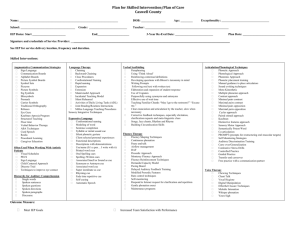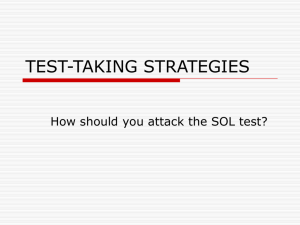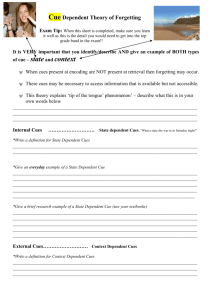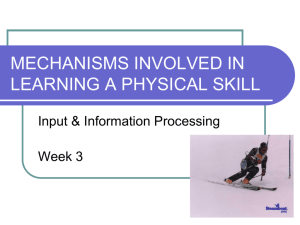Stages of Processing Skill Information
advertisement
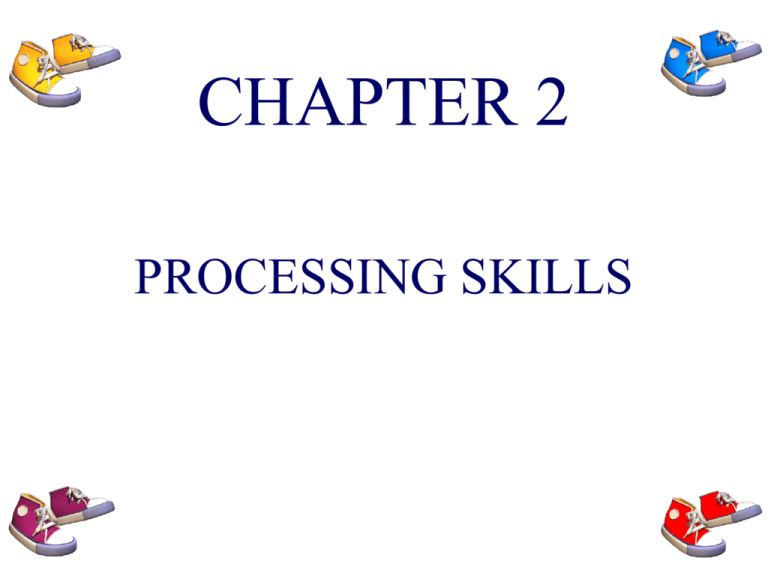
CHAPTER 2 PROCESSING SKILLS Stages of Processing Skill Information • Your skill performance is ultimately determined by: – Quality of environmental info you receive – How you learn the skill – The amount and type of previous experience you have had Stages of processing a skill • Input / stimulus – Info and signals we receive about the skill • Processing – How the info is processed to make a decision • Output / movement – Our response to decision made • Feedback – Our evaluation and use of the info we receive about our performance • Copy table 2.3 page 40 Stage 1 - Input • Info gathered from external by body’s sensory system and from the internal from proprioceptors (muscles/tendons, joints/nerves) • Exteroceptive Information – Performer receives info from external environment • Sight / hearing / touch (Field placings / speed of pitch etc) • Proprioceptive Information – Performer receives info from within the body • Tension in muscles / joints etc… • Batter feels a good hit • Checkpoints – page 42 Stage 2 - Processing • Made up of 3 components 1. 2. 3. 1. Stimulus identification (interprets and organises info) Response Selection (makes decisions about info) Response programming (coordinates movement response) STIMULUS IDENTIFICATION – Signal detection • Process of identifying the cues gathered by the senses – • • Signal detection affected by: » Cue intensity (signal size – larger balls / contrasting colours) » Length / Time of cue: (serves in tennis – 200kmh vs 160kmh) » Noise (distraction) » Capability of senses (good peripheral vision etc…) Of our 5 senses – the most important to affect your cue detection is sight, as most sports rely on visual cue detection Checkpoints 1 – 4 Page 43 Stage 2 – Processing (cont) Selective attention • • Process which directs our attention to a cue Influenced by 3 areas: 1. 2. 3. Arousal level (degree to which you are ready to receive a cue – too relaxed / too nervous etc..) Experience and Anticipation (ability to predict what is going to happen – not just a guess) Quality of Instruction (learners will benefit from meaningful cues) Response Selection • • Performer must decide on appropriate response Process is easier for an advanced performer as similar info held in long term memory Response Programming • • • Motor response / skill is an automatic response to the cues being observed Directly affected by reaction time Checkpoints 1, 3 Page 46 Stage 2 – Processing (cont) Reaction Time – Following factors affect reaction time: • • • • • Age and Gender (Men faster – older slower) Intensity of cue (louder / brighter = faster) Number of choices (greater choices = great RT) Probability of cue occurring (anticipating eg100m) Presence / absence of warning signs – Starter – on your marks / get set • Successive cues – brain can only process one cue at a time Complete Lab Report Page 53 Stage 2 – Processing (cont) • The role of memory:– plays important part in storage / processing of info – 3 types of memory are: 1. 2. 3. – Short term sensory store: limitless memory store – holds information for about 1 sec. Short term memory: ‘working’ memory limited to between 5-9 items – held for up to 1 min Long term memory: limitless store which holds relevant information for later use Relevance and meaning of information: – More likely to remember info if you are interested / meaningful to you – – Interference: noise etc. distracts you from remembering Coding and Chunking: improves short term memory by combining individual pieces of info – – – Eg: 9435310839 – 94 35 31 08 39 Rehearsal: practice info shortly after being told etc. Checkpoints: Page 55 – Q2,3 Stage 3 - Output • During the output stage the neuromuscular system automatically carries out response started / coordinated by CNS • Movement time: – time b/w starting and completing response • Response time: – onset of cue to completion of movt. • Reaction time + Movement time Stage 4 - Feedback • Info received by performers about their skill performance (positive and negative needed) • Main roles of feedback – Motivate – Reinforce – Change behaviour • Different forms of feedback: – Internal feedback • Info gained from inside the body (senses) – External feedback • Info from any external source – coach / video – Augmented feedback • Any additional info gained about movement – Knowledge of results (KR) – feedback from outcome (goal scored) – Knowledge of performance (KP) – feedback about movt characteristics » Eg golf swing – knowing head moved etc.. Stage 4 – Feedback (cont) • Factors that affect feedback – Stages of learning • Early stages - (KR) – simple not too much info • Intermediate / Advanced - (KP) – more detailed / technical info about timing and sequence of performance – Precision and Type of feedback • Needs to be precise, accurate and meaningful • Positive feedback is generally better than negative • Verbal, physical, written, video. – Effective Feedback – summarise table 2.2 Page 62 – Timing and Frequency of Feedback • Feedback can be used: – Before the movement (info retrieved from memory) – During the movement (concurrent feedback) – After the movement (terminal feedback) Information Processing – Skilled Performer • A skilled performer: – Has greater ability to detect cues – Can filter out noise and anticipate necessary response – Can reduce reaction time through practice – Is less easily tricked – Seems to have almost automatic response – Can utilise internal / external feedback more effectively • Checkpoints Page 65 – Q1,2,3 Year 11 - Homework • Stage 3: Output – Define Movement Time and Response Time – Copy Figure 2.15 – Page 56 • Stage 4: Feedback – – – – – – – Read Pages 57-65 What are the main roles of feedback? Define: Internal, External, Augmented feedback Define (KR) and (KP) What are the factors that effect feedback? Summarise the characteristics of a skilled performer. Complete checkpoints Page 65 – Q1,2,3



